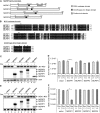MCPIP1 ribonuclease exhibits broad-spectrum antiviral effects through viral RNA binding and degradation
- PMID: 23355615
- PMCID: PMC3597685
- DOI: 10.1093/nar/gkt019
MCPIP1 ribonuclease exhibits broad-spectrum antiviral effects through viral RNA binding and degradation
Erratum in
-
Correction to 'MCPIP1 ribonuclease exhibits broad-spectrum antiviral effects through viral RNA binding and degradation'.Nucleic Acids Res. 2024 Jul 8;52(12):7398. doi: 10.1093/nar/gkae488. Nucleic Acids Res. 2024. PMID: 38828780 Free PMC article. No abstract available.
Expression of concern in
-
Expression of Concern on 'MCPIP1 ribonuclease exhibits broad-spectrum antiviral effects through viral RNA binding and degradation'.Nucleic Acids Res. 2024 Jun 10;52(10):6097. doi: 10.1093/nar/gkae342. Nucleic Acids Res. 2024. PMID: 38661204 Free PMC article. No abstract available.
Abstract
Monocyte chemoattractant protein 1-induced protein 1 (MCPIP1), belonging to the MCPIP family with highly conserved CCCH-type zinc finger and Nedd4-BP1, YacP Nuclease domains, has been implicated in negative regulation of the cellular inflammatory responses. In this report, we demonstrate for the first time that this RNA-binding nuclease also targets viral RNA and possesses potent antiviral activities. Overexpression of the human MCPIP1, but not MCPIP2, MCPIP3 or MCPIP4, inhibited Japanese encephalitis virus (JEV) and dengue virus (DEN) replication. The functional analysis of MCPIP1 revealed that the activities of RNase, RNA binding and oligomerization, but not deubiqutinase, are required for its antiviral potential. Furthermore, infection of other positive-sense RNA viruses, such as sindbis virus and encephalomyocarditis virus, and negative-sense RNA virus, such as influenza virus, as well as DNA virus, such as adenovirus, can also be blocked by MCPIP1. Moreover, the endogenous MCPIP1 gene expression was induced by JEV and DEN infection, and knockdown of MCPIP1 expression enhanced the replication of JEV and DEN in human cells. Thus, MCPIP1 can act as a host innate defense via RNase activity for targeting and degrading viral RNA.
Figures







References
-
- Gao G, Guo X, Goff SP. Inhibition of retroviral RNA production by ZAP, a CCCH-type zinc finger protein. Science. 2002;297:1703–1706. - PubMed
-
- Brown RS. Zinc finger proteins: getting a grip on RNA. Curr. Opin. Struct. Biol. 2005;15:94–98. - PubMed
-
- Hall TM. Multiple modes of RNA recognition by zinc finger proteins. Curr. Opin. Struct. Biol. 2005;15:367–373. - PubMed
Publication types
MeSH terms
Substances
LinkOut - more resources
Full Text Sources
Other Literature Sources
Molecular Biology Databases
Research Materials

